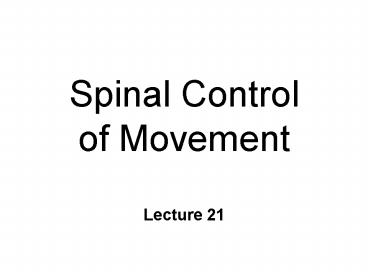Spinal Control of Movement - PowerPoint PPT Presentation
1 / 35
Title:
Spinal Control of Movement
Description:
Cell body in ventral horn. Emerge from ventral root. Innervate extrafusal fibers ... Muscle tone. knee-jerk reflex. Muscle spindles. length detectors. Low threshold ... – PowerPoint PPT presentation
Number of Views:136
Avg rating:3.0/5.0
Title: Spinal Control of Movement
1
Spinal Control of Movement
- Lecture 21
2
Spinal Motor Circuits
- Local control of stereotyped movement
- reflexes rhythmic motor patterns
- based on spinal interneurons a motor neurons
- Same circuits used for voluntary movements
- controlled by descending fibers
- upper motor neurons
3
Spinal Motor Circuits
- Sensory feedback
- somatosensory receptors
- cutaneous receptors
- Golgi tendon organs
- muscle spindles
- intrafusal fibers
- g motor neurons
4
Spinal Cord
- Muscles their neurons not evenly distributed
- C3 - T1 Arms
- cervical brachial plexuses
- L1 - S3 Legs
- lumbar sacral plexuses
- Spinal cord enlarged
- more neurons in ventral horns
5
a Motor Neurons
- Cell body in ventral horn
- Emerge from ventral root
- Innervate extrafusal fibers
- Uninterrupted to muscle fibers
- final common pathway
- Only excitatory input to muscles
- Inhibition at spinal cord
- Cholinergic
6
ACh
a motor neuron
7
Input to Alpha Motor Neurons
- 3 sources only
- 1. DRG neurons
- sensory neurons (proprioception)
- feedback from muscle spindles
- 2. Upper motor neurons
- primarily from M1
- 3. Spinal interneurons
- most input (excitatory inhibitory)
- generation of motor programs
8
Inputs to Alpha Motor Neurons
Sensory neurons
Dorsal
DRG
Spinal interneurons
Upper motor neurons - M1
Ventral
9
Movement of Limbs
- Flexors and extensors are ANTAGONISTIC
- muscles and are reciprocally innervated
- Limb flexion
- flexors excited extensors inhibited
- Limb extension
- extensors excited flexors inhibited
- Disynaptic inhibition
10
Upper Motor Neurons
11
Monosynaptic Stretch Reflex
- Postural adjustments
- Muscle tone
- knee-jerk reflex
- Muscle spindles
- length detectors
- Low threshold
- Sensory neuron ---gt alpha motor neurons
- monosynaptic excitation
- disynaptic inhibition
12
13
Intrafusal Muscle Fibers
- Control tension on muscle spindles
- Not force for movement
- Innervated by g motor neurons
- active concurrently with a motor neurons
- Load the Spindles
14
M S
15
APs
tension
16
Muscle Stretched
APs
tension
17
Muscle Contracts
APs
contraction
18
Muscle Contracts
APs
contraction
19
Muscle Contraction
- alpha ----gt extrafusal
- gamma ----gt intrafusal
- alpha gamma fire together
20
M S
gamma
alpha
21
Polysynaptic reflexes
22
Myotactic Reflex
- Golgi Tendon Organ
- Gauges muscle tension
- controlled contractions
- safety mechanism
- Inhibits a motor neurons
- disynaptic inhibition
23
Dorsal
Inhibits a motor neuron
-
Ventral
24
Withdrawal Reflex
- Flexion
- remove limb from noxious stimulus
- Polysynaptic reflex
- sensory neuron
- interneurons
- motor neuron
- 2 or more synapses
- slower than monosynaptic
25
Polysynaptic withdrawal reflex
R
26
Dorsal
Ventral
27
Withdrawal Reflex
- also influences other muscles
- e.g. Step on tack
- flexion of ipsilateral limb
- simultaneous extension of contralateral leg
- excite extensor
- inhibit flexor
28
Generation of Rhythmic Motor Patterns
29
Central Pattern Generators
- Half-center Model
- alternating activity in flexor extensor
- Step-cycle has 2 phases
- swing phase
- foot off ground flexing forward
- stance phase
- foot planted leg extending
- Each limb has own pattern generator
30
Half-center Model
Flexor
a
Tonic input
a
Extensor
31
Rhythmic Patterns Sensory Feedback
- Not necessary for locomotion
- but slower, less coordinated
- Stumble correction reaction
- during swing phase
- tactile stimulus on dorsal foot ---gt flexion
- Reflex reversal
- override during extension
- flexion would cause collapse
32
Goal-directed Locomotion
- Requires intact supraspinal systems
- Coordination of antigravity muscles
- Brainstem motor nuclei
- modulation of contraction strength
- Reticulo-, rubro-, corticospinal
- Balance
- Vestibulospinal tract (Ventromedial)
- Also cortical subcortical areas
33
Movement DisordersSpinal Cord
34
Spinal Cord Pathology
- Poliomyelitis
- virus attacks motor neurons
- wasting of muscles, paralysis
- may have virus but not polio
- still contagious
- vaccine, but still cases
- concerns of developing in tropics
35
Spinal Cord Pathology
- Trauma
- bruised or severed
- injury worsened by
- inflamation
- endorphins
- excitoxicity
- Treatment - regeneration
- implant peripheral nerve
- neural tissue transplants































